Ferrari Testarossa
(1985)
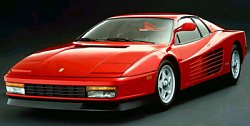 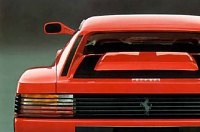 If you are not old enough, you may have missed the "supercar good old days" running from 1960s to 1980s. In that era, every supercar had to look sensational and inspire imagination like reading science fictions. The trend was started by Lamborghini Miura in 1960s and elevated to a higher level in 1970s by Lamborghini Countach. In 1980s, it was Ferrari Testarossa that set every car enthusiast on fire. 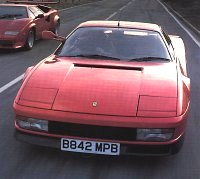 I saw Testarossa for the first
time in 1986, two years after its debut
in Paris motor show. Its gorgeous design captured my heart instantly.
Never before had a car incorporated side intakes so spectacular and so
stylish, thanks to the signature "cheese-slicer" grilles. Above the
grilles was a belt line flowing smoothly upward while widening towards
the tail. It eventually left the flying buttresses and merged
flawlessly with the tail to become the widest tail I had ever seen in a
car. The visual impact was so great that every designer wondered how
Pininfarina could think of it. I saw Testarossa for the first
time in 1986, two years after its debut
in Paris motor show. Its gorgeous design captured my heart instantly.
Never before had a car incorporated side intakes so spectacular and so
stylish, thanks to the signature "cheese-slicer" grilles. Above the
grilles was a belt line flowing smoothly upward while widening towards
the tail. It eventually left the flying buttresses and merged
flawlessly with the tail to become the widest tail I had ever seen in a
car. The visual impact was so great that every designer wondered how
Pininfarina could think of it.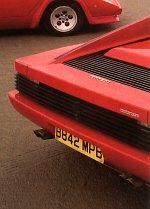 The design team at Pininfarina
consisted of Ian Cameron, Guido Campoli,
Diego Ottina and Emanuele Nicosia. With little surprise, they were led
by design chief Leonardo Fioravanti, the maestro behind many beautiful
Ferraris. The design was originated by Nicosia, but we can say the
guidance of Fioravanti was equally important. Being a trained
aerodynamist, Fioravanti applied his know-how to set the aerodynamics
layout of the car. This mean the large side intakes were not only a
statement of style but really functional – they drew clean air to cool
the side radiators and then went upward and left the car through the
ventilation holes located at the engine lid and the tail. As a result,
the Testarossa did not need a rear spoiler like Lamborghini Countach
yet produced zero lift at its rear axle. The aerodynamic drag
coefficient of 0.36 was also way better than the Lamborghini's 0.42. The design team at Pininfarina
consisted of Ian Cameron, Guido Campoli,
Diego Ottina and Emanuele Nicosia. With little surprise, they were led
by design chief Leonardo Fioravanti, the maestro behind many beautiful
Ferraris. The design was originated by Nicosia, but we can say the
guidance of Fioravanti was equally important. Being a trained
aerodynamist, Fioravanti applied his know-how to set the aerodynamics
layout of the car. This mean the large side intakes were not only a
statement of style but really functional – they drew clean air to cool
the side radiators and then went upward and left the car through the
ventilation holes located at the engine lid and the tail. As a result,
the Testarossa did not need a rear spoiler like Lamborghini Countach
yet produced zero lift at its rear axle. The aerodynamic drag
coefficient of 0.36 was also way better than the Lamborghini's 0.42. From the beginning, Ferrari wanted to replace its flagship supercar 512BB by a more rounded successor. It had to comply with US Federal emission and safety legislation from the outset, so it would be Ferrari's first "World Car". It had to offer a roomier cabin and better creature comfort to please the millionaires affording the car. At the same time, it had to be faster yet easier to handle. Basically, the tubular spaceframe chassis was a development from its predecessor, with wheelbase stretched from 2500 to 2550 mm to free up cabin space. Unlike 512BB, Testarossa had its radiators and fuel tank relocated to the middle of the car. This enabled a sizable front luggage compartment. At nearly 2 meters wide, the Testarossa was the widest car available then and exceeded Lamborghini Countach. Most of the bodyshell was made of aluminum panels while the doors and roof were galvanized steel. The plastic bumpers incorporated smoothly into the body. The whole car weighed 1506 kilograms dry, a heavyweight by contemporary standard. 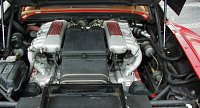 The powertrain was also a
development from the Berlinetta Boxer. It was
a 5-liter horizontally-opposed 12-cylinder engine that Ferrari referred
to "180-degree V12" - this was quite right because it had each crankpin
shared by two adjacent cylinders, something like a V-engine. Extensive
modifications cut 20 kilograms from its weight and brought
Quattrovalvole (4-valve) heads for the first time. The new cylinder
heads were painted in red, hence giving the name Testarossa ("red head"
in Italian), just like the 1958 Ferrari road racer. Also new was Bosch
K-Jetronic fuel injection and Marelli Multiplex ignition. With a
compression ratio of 9.2:1, the engine produced 390 horsepower at 6300
rpm, some 50 horses more than the last 512BBi. After series of detune
during the life time of BB, Ferrari's flagship supercar was finally
back to form. It managed a real 181 mph and 0-60 mph was done in 5.2
seconds. So fast that it nearly matched the limited production 288GTO !
so embarrassing to Ferrari… The powertrain was also a
development from the Berlinetta Boxer. It was
a 5-liter horizontally-opposed 12-cylinder engine that Ferrari referred
to "180-degree V12" - this was quite right because it had each crankpin
shared by two adjacent cylinders, something like a V-engine. Extensive
modifications cut 20 kilograms from its weight and brought
Quattrovalvole (4-valve) heads for the first time. The new cylinder
heads were painted in red, hence giving the name Testarossa ("red head"
in Italian), just like the 1958 Ferrari road racer. Also new was Bosch
K-Jetronic fuel injection and Marelli Multiplex ignition. With a
compression ratio of 9.2:1, the engine produced 390 horsepower at 6300
rpm, some 50 horses more than the last 512BBi. After series of detune
during the life time of BB, Ferrari's flagship supercar was finally
back to form. It managed a real 181 mph and 0-60 mph was done in 5.2
seconds. So fast that it nearly matched the limited production 288GTO !
so embarrassing to Ferrari…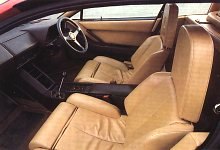 At that time, people usually
compared Testarossa with Lamborghini
Countach QV. Undeniably, the Countach was its only direct competitor in
the market. Both occupied the same price segment, both offered a
powerful 12-cylinder engine mounted amid-ship and both offered similar
performance. The Lamborghini was slightly faster in acceleration but
its poorer aerodynamics lost the edge to Ferrari when approaching top
speed. People described the Lambo as an uncompromising wild beast while
they referred Testarossa to "a gentleman's supercar". Never before an
Italian supercar was so easy to live with. Its cabin was roomy and
accommodated tall drivers easily. It offered a useful luggage space
behind the seats as well as in the front luggage compartment. It
provided very good visibility for a mid-engined machine. Access to the
cabin through the large, conventionally hinged doors and narrow sills
was easy. You can even describe it as luxurious, thanks to the
electrically adjustable leather seats, power windows and air
conditioning, despite of the Fiat-sourced switch gears. To drive it was
also relatively easy. Its unassisted steering was not as heavy as
Lamborghini's. Its clutch and brake pedals were lighter still. Ferrari
rounded most of the rough edges normally associated with traditional
supercars. Performance and ease of driving were no longer mutually
exclusive. At that time, people usually
compared Testarossa with Lamborghini
Countach QV. Undeniably, the Countach was its only direct competitor in
the market. Both occupied the same price segment, both offered a
powerful 12-cylinder engine mounted amid-ship and both offered similar
performance. The Lamborghini was slightly faster in acceleration but
its poorer aerodynamics lost the edge to Ferrari when approaching top
speed. People described the Lambo as an uncompromising wild beast while
they referred Testarossa to "a gentleman's supercar". Never before an
Italian supercar was so easy to live with. Its cabin was roomy and
accommodated tall drivers easily. It offered a useful luggage space
behind the seats as well as in the front luggage compartment. It
provided very good visibility for a mid-engined machine. Access to the
cabin through the large, conventionally hinged doors and narrow sills
was easy. You can even describe it as luxurious, thanks to the
electrically adjustable leather seats, power windows and air
conditioning, despite of the Fiat-sourced switch gears. To drive it was
also relatively easy. Its unassisted steering was not as heavy as
Lamborghini's. Its clutch and brake pedals were lighter still. Ferrari
rounded most of the rough edges normally associated with traditional
supercars. Performance and ease of driving were no longer mutually
exclusive.On the road, the Testarossa was most impressive for its engine and high-speed performance. On paper, the 4943 cc boxer engine was 65 horsepower short of Lamborghini's 5.2-liter V12. In fact, it was actually the better engine. Strong and free-revving aside, it was markedly smoother than the Lamborghini engine and played more lovely music. Today, the boxer rhythm is still unsurpassable by any Ferrari V12s. 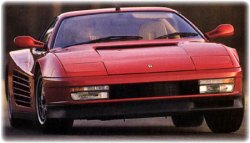 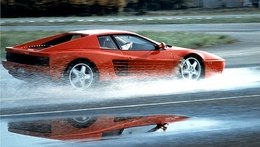 Drive the Testarossa to 170 mph and it would remain remarkably stable, thanks to the superb aerodynamics. By supercar standard, its suspension was unusually soft thus gave a comfortable ride never found in other exotics. On the down side, its body rolled quite a lot in bends - a thing made worse by the drivetrain layout – like BB, the boxer engine was mounted above the transmission and final drive thus it had a center of gravity higher than a supercar deserved. The Testarossa was never a car you can push very hard in corners, unlike the limited production GTO or Porsche 959. Exceeding its limit, the body roll would induce oversteer, throwing its heavy tail out of bend and then it would be difficult to rescue. Moreover, on tighter roads you always aware the extreme width of the car. These dynamic deficiencies were not dealt with until its successor 512TR… However, the beauty, the speed and the easy going manner helped Testarossa to won the biggest sales success in Ferrari's history. Within 7 years, some 7,177 copies of this very expensive model were sold. Many of which went to the USA. In addition to its derivative 512TR and F512M, close to 10,000 units of the Testarossa family were produced, setting an all-time record for supercars which is still unsurpassable today. 512TR 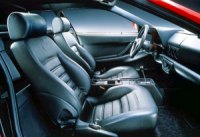 Externally, 512TR differed from its predecessor by a smoother bumper which incorporated a "smiling" grille, plus the black rubber chin spoiler and side skirts were replaced by body-colored items. However, mechanical-wise the car was a vast improvement from Testarossa. First of all, the flat-12 engine was heavily modified with new heads and block, increased compression (10.0:1) and Bosch Motronic engine management system to gain another 38 horsepower. Then the engine and gearbox unit was mounted lower in the chassis to ensure a lower center of gravity. The chassis was strengthened by 13 percent in torsion. The suspensions received a lower ride height, revised tuning and gas-filled dampers. They rode on larger 18-inch wheels and wider Pirelli P-Zero tires to improve cornering trip. The steering rack was quickened a little. The ventilated discs were also upgraded. Inside, the cabin was retrimmed with higher quality materials while new bucket seats provided better lateral support. 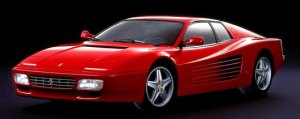 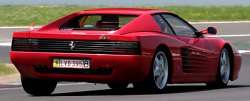 These modifications were very successful. Although the 512TR was still slower than Lamborghini Diablo, its handling was completely transformed. It became sharp, alive and totally under control. The rear-end roll disappeared, replaced by a stable and accurate body control. Despite of the enormous width, it can be placed accurately on narrow country roads because the steering was so precise and communicative. At the limit - which was much higher than Testarossa, the TR still oversteered, but at a more benign rate and was much easier to tame. At the same time, it retained the fine ride quality and easy to drive manner of Testarossa. It also had the best engine in the world. No wonder Autocar magazine described it as the finest supercar in production and not even Diablo could live with. 512TR should have surpassed the success of Testarossa. Unfortunately, it was born during economy recession and a time the market was overcrowded with ultra-expensive supercars. Still, 2280 units sold in 3 years was a respectable result. F512M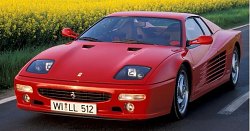 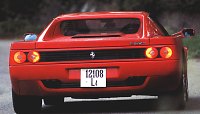 The engine was also lighter. More weight was eliminated by employing lighter wheels and by replacing the pop-up headlamps with fixed ones. Sadly, the organic shape of the new headlamps, fog lamps and bumper intakes did not gel with the sharp-edge design and simply ruined the beauty of the original car. At the rear, it switched to quad-circular taillights and tidied up the bumper and air vents. Still, the F512M would be remembered only for its ugliness.  For the chassis tuning, Ferrari wanted to make the car sharper and more hardcore to drive. Unfortunately, it repeated the faults of 348 and resulted in a car more nervous and more tail happy at the limit. The F512M was actually more difficult to drive than 512TR, although it was marginally faster. It was therefore the least loved version of the Testarossa family. Only 501 units were sold until 1996. After that, Ferrari terminated its mid-engined flagship line as well as the boxer engine. They were replaced by the front-engined, V12-powered grand tourer, 550 Maranello. A great era ended in this way. |